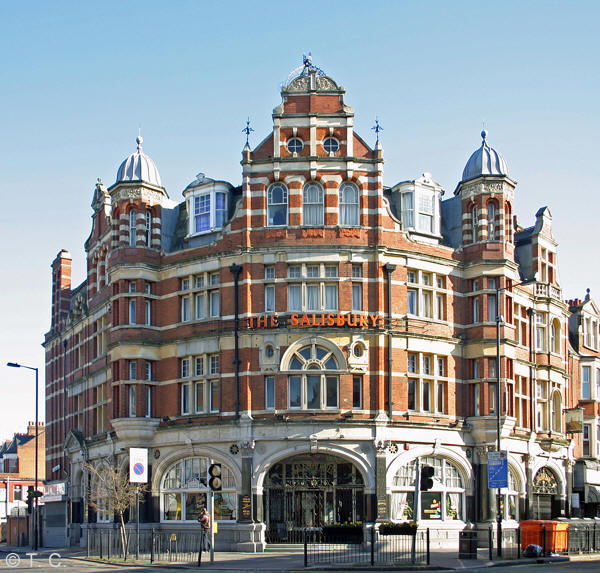 The Salisbury was built and designed by John Cathles Hill,
The Salisbury was built and designed by John Cathles Hill, founder of The London Brick Company. The pub was opened in 1899 with W.A. Cathles, a cousin of Hill, as the manager.Its construction cost of £30,000 is the equivalent of approximately £7 million at 2008 values.
founder of The London Brick Company. The pub was opened in 1899 with W.A. Cathles, a cousin of Hill, as the manager.Its construction cost of £30,000 is the equivalent of approximately £7 million at 2008 values.It caused something of a stir when it opened, being described by the trade journal, The Licensed Victualler and Catering Trades' Journal in the most glowing terms:

| “ | The position it occupies with regard to other "houses" is unique, because of its combination of several distinct establishments. In this it is a paradox, as the hotel, restaurant and public house which it comprises are distinct, but they are nevertheless equally one. The hotel is one of the finest which exists at the present day; it is one also which will take a genius to eclipse.....and the district (in which it was built) has been turned into one of London's finest suburbs. | ” |
In 2003, following a period of delapidation and decline, and temporary closure, it was sympathetically restored and reopened.
In 2008, beer and architecture experts Geoff Brandwood and Jane Jephcote, selected The Salisbury as one of London's top ten heritage pubs in their book, London Heritage Pubs - An Inside Story.lThe exterior is classified as French Renaissance style with shaped gables, ogee domed cupolas and large pedimented dormers. It is constructed of red brick with stone bands and dressings. Its slated mansard roof has a high central tower topped with a wrought-iron crown. The pub has three stories and attic. Polished black larvikite Corinthian pilasterssupport the fascia. The entrances have ornate wrought-iron screens above imposts, with elaborately tiled lobbies and mosaic floors.
The pub's interior was described by the architectural historian Mark Girouard as a magnificently elaborate and complete interior.
On the first floor there is a large room at the front which was in the past used as a restaurant and concert room. It has an elaborate, compartmented ceiling with ornate fibrous plasterwork, all by the Mural Decoration Company. There is also notable engraved glass by Cakebread & Robey in the doors separating off the residential part of the building.This floor was previously used as a church, but has recently been renovated into an expansive luxury apartment.
The bar area has a compartmented ceiling with cast-iron columns. There is a large, curved wooden bar with a stone trough at its base. The bar forms a complete rectangle serving all parts of the large space. The saloon and public bars are divided by a wooden, arched screen containing glass engraved with Art Nouveau motifs . At the rear is the former billiard room, now a restaurant, with top-lit roof glass painted with a creeping vine motif. There are many elaborate engraved mirrors, some stained-glass windows and fire surrounds
. At the rear is the former billiard room, now a restaurant, with top-lit roof glass painted with a creeping vine motif. There are many elaborate engraved mirrors, some stained-glass windows and fire surrounds
 . At the rear is the former billiard room, now a restaurant, with top-lit roof glass painted with a creeping vine motif. There are many elaborate engraved mirrors, some stained-glass windows and fire surrounds
. At the rear is the former billiard room, now a restaurant, with top-lit roof glass painted with a creeping vine motif. There are many elaborate engraved mirrors, some stained-glass windows and fire surrounds
No comments:
Post a Comment